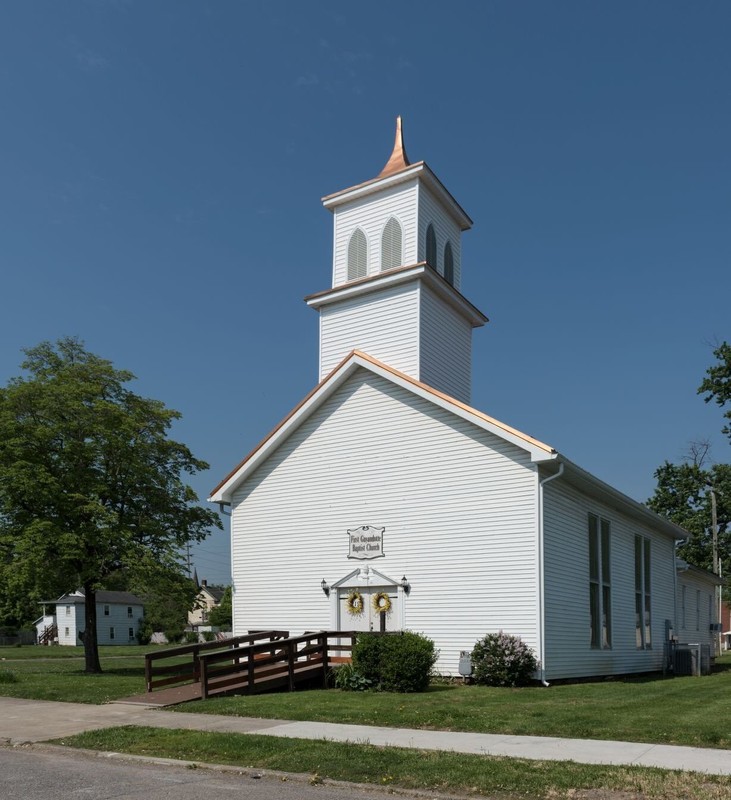First Guyandotte Baptist Church
Introduction
Text-to-speech Audio
Images
The First Guyandotte Baptist Church's current building was constructed in 1867 on the same foundation as the previous structure, which was destroyed during the Civil War. Image obtained from the Library of Congress.

Backstory and Context
Text-to-speech Audio
The Baptists were one of the first religious denominations to organize congregations west of the Appalachian Mountains, with the earliest attempt dating to the 1740s. By 1800 there were at least sixteen Baptist churches in present-day West Virginia. Many of these churches formed associations, which loosely united congregations within a certain area. These associations helped provide churches with ministers, financial support, and maintain adherence to Baptist doctrine. At some point a Guyandotte Baptist Association was created for Cabell County and the surrounding area; the First Guyandotte Baptist Church became the Association’s second member.
Some sources state that a Baptist church existed in Guyandotte as early as 1812, if not earlier, but no known written records exist to prove these claims. It is generally recognized that the First Guyandotte Baptist Church was formally organized on November 8, 1858. It originally had fourteen charter members, and a J. C. Reece served as the first pastor. Little is known about the early years of the church because many of the records are believed to have been destroyed during the Civil War. Sometime after the church’s establishment a brick sanctuary was constructed on Richmond Street. It also contained an interior gallery for slaves to attend services.
It is unclear whether or not the Baptist Church supported slavery, but most of the town of Guyandotte supported slavery and secession during the Civil War. On November 11, 1861, the church became one of two (along with the Guyandotte Methodist Church) to be destroyed by Union troops in retaliation for casualties incurred during the Battle of Guyandotte on November 10. Reportedly it took Union troops three tries to burn down the sanctuary; after two failed tries, the soldiers ripped off the shutters, stuffed them with straw, and then set them alight inside the belfry.
After the war a new church building was erected on the same site as the original in 1867. This sanctuary, which still stands today, featured white siding and was based off the Greek Revival Victorian style of church architecture. Decades later the members of the church petitioned the federal government to compensate the congregation for damages incurred by Union forces during the war. Congress finally awarded the church $2,500 in damages in 1909.
Sources
Buzek, Dorothy. “Faith in Huntington: First Baptist Church of Guyandotte Plans to Mark Centennial This Year.” Herald-Dispatch. 1958.
Geiger, Joe Jr. “The Tragic Fate of Guyandotte.” West Virginia History 54 (1995): 28-41.
Highsmith, Carol M, photographer. First Guyandotte Baptist Church, Huntington, West Virginia. Huntington United States West Virginia, 2015. -05-08. Photograph. https://www.loc.gov/item/2015631875/.
Lavender, Dave. “Guyandotte homes full of rich history.” Herald-Dispatch. November 5, 2011. Accessed July 26, 2019. https://www.herald-dispatch.com/features_entertainment/guyandotte-homes-full-of-rich-history/article_fcb3dd4b-8aab-54f1-ab37-7ed1f909aa4e.html.
Nance, Karen and Friends of the Madie Carroll House. Walking Tour of Downtown Guyandotte. Huntington, WV: The Herald-Dispatch.
Rogers, George Truett. “Baptists.” e-WV: The West Virginia Encyclopedia. November 20, 2010. Accessed July 27, 2019. https://www.wvencyclopedia.org/articles/344.
